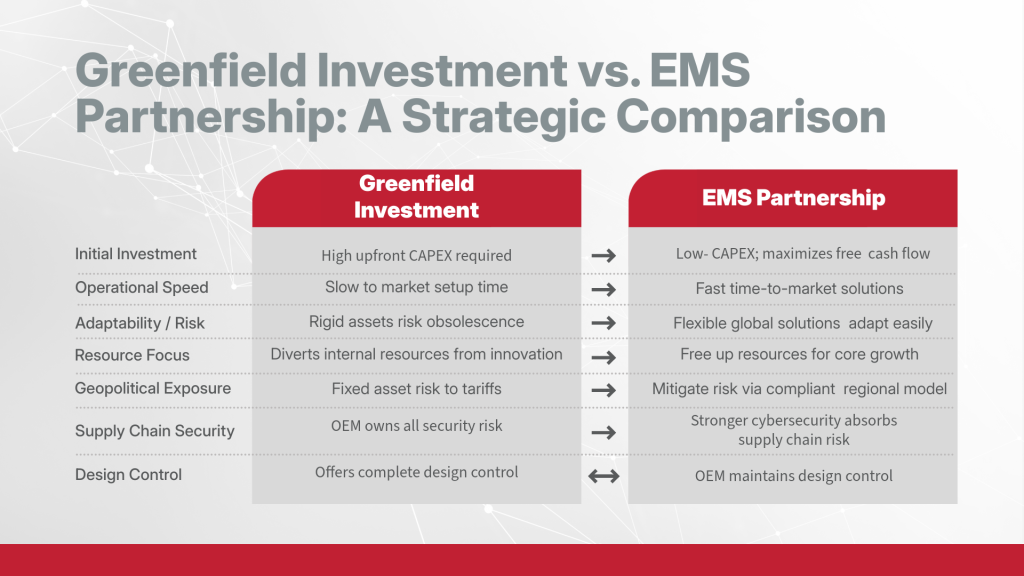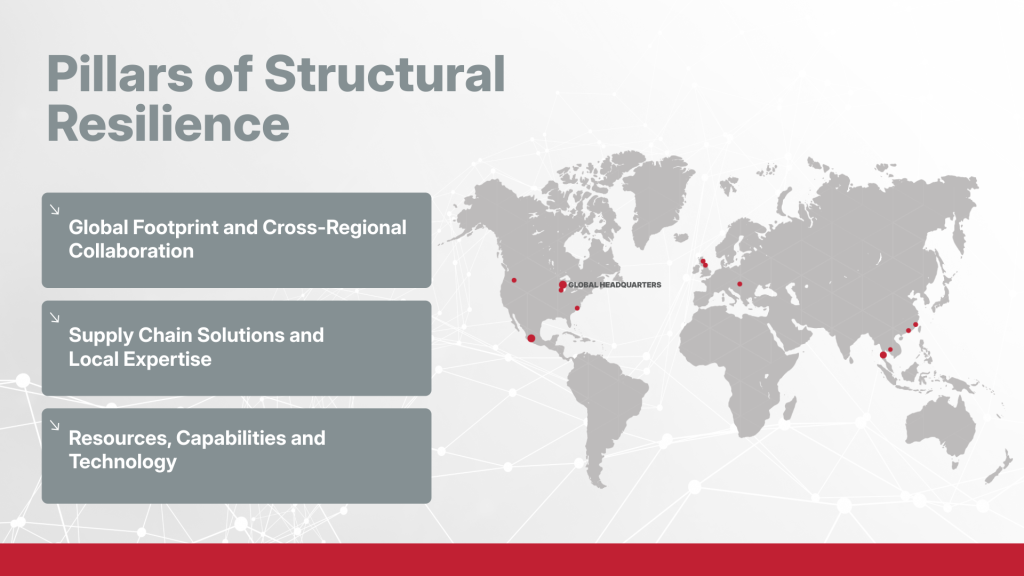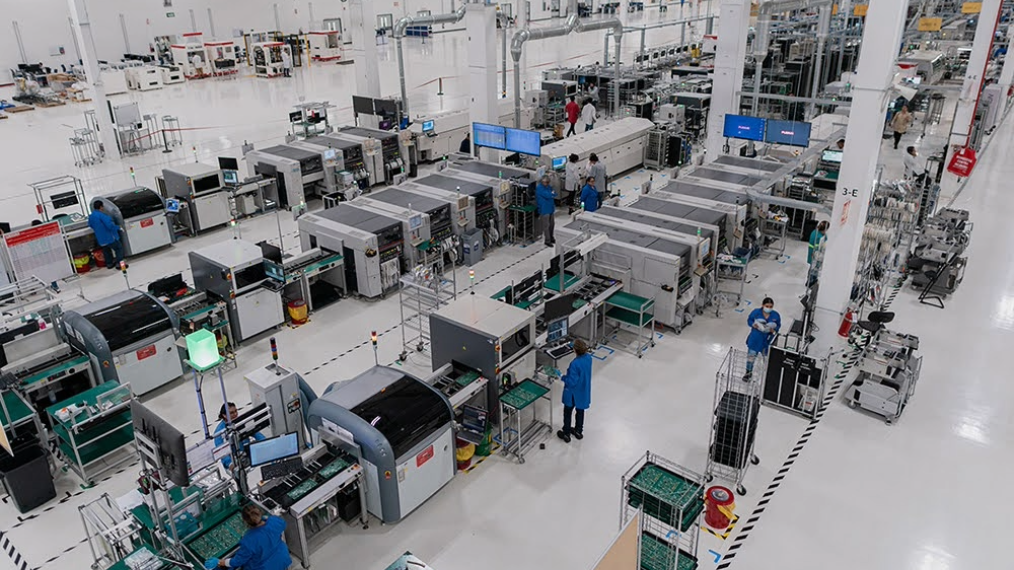What’s Your Plan B: How to Build Up Business Resilience

In a world shaped by geopolitical tensions, trade barriers and volatile market demands, industrial manufacturers are encouraged to rethink their operational foundations and how they manage their risks. Globalized production networks are proving vulnerable and a reliance on reactive, short-term fixes is no longer sustainable. To ensure continuity and competitiveness, companies must now build structural business resilience.
To address these demands effectively and quickly, original equipment manufacturers (OEMs) should consider partnering with a globally integrated electronics manufacturing services (EMS) provider. An EMS partner provides the flexible global footprint, expert solutions and resilient operational pathway that an industrial OEM can leverage to absorb shocks, manage supply chain complexities and scale globally with minimized risk.
The Rising Pressure to Be Prepared
Industrial OEMs are currently navigating a turbulent landscape defined by critical threats. The most immediate is the surge in geopolitical and protectionist challenges, particularly in the U.S. and other key markets. This volatility, driven by rising tariffs and “Made in the Country” content requirements, necessitates a strategic shift toward localized supply chains that serve as a strong geopolitical risk mitigation strategy.
The conventional response—creating a greenfield operation by building a new factory and supply chain from scratch—is risky and can have a negative impact on the company’s resilience. Because it requires a long lead time and consumes significant amounts of CAPEX, management time, and cash, it risks diverting financial and human resources from core profit, growth and competitive differentiation drivers of technology innovation and customer development.
Moreover, this approach creates rigidity, risking massive investments in fixed infrastructure that may become obsolete if regulations change and market demand shifts. For an industrial OEM seeking to boost its business resilience, this risky model requires a smarter alternative: one that allows them to avoid CAPEX manufacturing investment.
Another common and growing vulnerability is the lack of true multi-tier supply chain visibility. Many dual-sourcing strategies become ineffective when companies discover that both suppliers rely on raw materials from the same upstream facility, which prevents them from identifying critical risk factors. Further, lack of visibility into the supply chain can increase the risk of modern threats, such as cyber attacks on suppliers that impact the OEM downstream.
To meet these comprehensive pressures, companies must shift from reactive management to proactive strategies. A proactive approach should embrace faster, more agile decision-making and build greater flexibility into an OEM’s operations.

Resilience vs. Reactivity: The Shift to “Resilience as a Service”
Market trends show a clear move away from the traditional, linear supply chain model toward structural preparedness. Companies across many industries are investing in re-shoring by establishing regional supply chains (e.g., EMEA solutions for the EMEA market) to mitigate geopolitical risk.
This shift is where a strategic EMS partner like Plexus becomes vital. We deliver integrated, agile design, manufacturing and servicing solutions by leveraging our established global footprint. This provides a lower-risk, more financially attractive and flexible alternative to large-scale, fixed investments.
Pillars of Structural Resilience

Global Footprint and Cross-Regional Collaboration
Building a resilient footprint demands frictionless geographic expansion. To achieve this, OEMs can leverage an EMS partner that can provide immediate, cross-regional consistency, enabling them to meet complex compliance requirements globally. Building a global footprint demands a solid strategic partnership for designing, manufacturing and servicing at scale, that can flex to meet market requirements without requiring the client to significantly increase its fixed costs investments.
Achieving this consistency requires the best EMS partners to maintain strong systems to ensure exceptional customer service across their footprint.
One advantage is operating on a unified secure IT/ERP platform for a seamless communication backbone and standardized processes worldwide. Strong EMS partners also foster a unified culture built through organic growth to guarantee consistent quality and reliable support across all sites. Great EMS companies also maintain strategic focus on key global market sectors, ensuring the customer receives a cohesive, expert-led experience reinforced by executive commitment. This unified system minimizes friction and risk, allowing industrial OEMs to secure global design, manufacturing and servicing scale efficiently.
Supply Chain Solutions and Local Expertise
The most vulnerable supply chain models are those not architected against protectionism. While eliminating all risk is impossible, the key to resilience lies in understanding and mitigating vulnerabilities by moving toward a region-of-consumption model.
An EMS partner addresses this by incorporating supply chain decisions early in product design and helping establish strong, localized supply chains near a company’s end markets. This expertise also extends to regulatory complexity: for example, the Mainland Europe and UK defense markets have unique compliance standards that call for a partner with significant on-the-ground knowledge.
Resources, Capabilities and Technology
While new technologies like AI, blockchain, and digital twins are powerful enablers of resilience—AI for predictive analytics, blockchain for traceability and digital twins for optimization—manufacturers often lack the necessary capital, specialized facilities and skilled labor to fully implement them. Therefore, the most efficient way to leverage these capabilities is by partnering with a provider who has already made the necessary investments in the technology and human capital, ensuring continuous access to advanced tools without capital diversion.
The Power of Strategic Partnerships: Resilience as a Service
Plexus acts as a comprehensive, ready-made solution for navigating a volatile world, providing a platform for faster time-to-market and ensuring continuity of delivery. By leveraging our established footprint, customers avoid the significant CAPEX, lead time, and risk associated with building their own operations. This allows them to optimise their balance sheet and P&L by focusing financial resources towards core growth.
Case Example: Supporting a Power Electronics Leader to Scale Fast
A major European provider of complex high-tech power systems faced significant challenges in scaling its manufacturing fast enough to meet rising global demand and comply with regional regulations. Plexus provided an EMS alternative to greenfield investment, enabling the client to implement a fast, compliant and de-risked manufacturing plan.
Plexus provided a comprehensive solution to help them navigate this challenge:
- Global Footprint and Scalability: Plexus’s integrated global network allowed the company to meet rapidly increasing global demand faster than its competitors. It provided a direct pathway to avoid CAPEX manufacturing investment, supporting the goal of growing its market share.
- Trade Compliance Expertise: The company required a solution that could address “Made in the U.S.” content requirements. Plexus’s trade compliance expertise enabled them to identify and recommend a hybrid supply chain and manufacturing solution to meet the requirements of the Buy America and Trade Agreement Acts.
- Integrated Operational Optimization: The partnership enables the company to optimize its P&L and balance sheet by leveraging Plexus’s operational footprint. This allowed the company to fulfill global demand and focus its own resources on core activities like technology innovation and customer growth.
Conclusion: Don’t Wait for the Crisis
Business resilience is not a contingency plan; it’s the industrial OEM’s competitive edge. By partnering with a global EMS provider, industrial OEMs can strengthen design, optimize their supply chain and gain the manufacturing scale required for success in a volatile market. This collaborative approach enables both rapid growth and the operational independence required to maximise returns to their investors.


